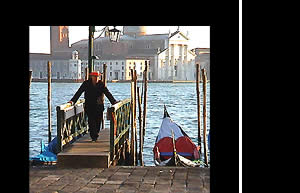|
Veneto Region
Even in our days, the history of the Veneto
region still seems mysterious and arouses our curiosity.
Culture blends in perfectly with the wonderful scenery of
Lake Garda, the beautiful villas scattered across the green
countryside, the enchanted mountains of the Dolomites with
their spectacular peaks and one of the most beautiful cities
in the world: Venice.
In an incredible position on the Lagoon of Venice, stands
a group of small islands linked by canals crossed by fascinating
bridges, like the famous seventeenth-century Bridge
of Sighs,
so called because of the lamentations of the prisoners on
their way to face the State inquisitors, and the Rialto
Bridge,
on the Grand Canal, from the balustrades of which there are
lovely views. Wonderful Saint Mark’s Square is in the
centre of the city, overlooked by the impressive Byzantine
Basilica, one of the buildings with the richest marble and
mosaic decorations in the world, alongside the Doge’s
Palace, an exceptional example of Gothic architecture. A
passageway leads underneath the renaissance clock tower,
the Torre dell’Orologio, to the Mercerie district,
a jumble of alleyways full of shops, and an ideal place for
shopping. You can make your visit very pleasant by taking
a ride in a gondola or stopping at one of the famous historical
cafes, like the Caffè Quadri or the Florian, the meeting
place of famous literary figures such as Proust, Dickens
and Byron. or at Harry’s Bar, which Hemingway was so
fond of: here you can drink an excellent Bellini, an aperitif
made from a lightly sparkling white wine called prosecco and white peach juice.
If you would like to see the works of Titian, the remarkable
painter whose paintbrush the great Charles V bent down to
pick up when it fell, you should go to the Frari basilica
and to the church of Santa Maria della Salute where Tintoretto’s
wonderful painting, the Marriage Feast of Cana is also kept.
Tintoretto is also famous for the decoration of the walls
and ceilings of the Scuola Grande di San Rocco.
Then there is La Pietà, Vivaldi’s church, where
the great composer was once musical director and which became
famous because of his magnificent performances.
To get an idea of the great naval power of the Republic of
Venice in bygone days you can make an interesting visit to
the enormous shipyard in the Arsenale district, while Ca’ d’Oro (the “golden house” because its facade was once
gilded), a building in Gothic-Venetian style with oriental
influence in the facade, is one of the most beautiful in
the city: it has a picture gallery with Mantegna’s
Saint Sebastian and Titian’s Venus
at the Mirror.
Venice is the venue of important cultural events such as
the Art Biennial, and the International
Film Festival at
the Lido, a well-known seaside resort. The sparkling costumes,
fanciful masks, open-air balls and processional floats of
the Carnival make this festival, dating back to the 11th
century, the most beautiful event of the year. Also interesting
is the Feast of Saint Mark, on 25 April, celebrated by a
gondola race, and the Regata Storica (historic regatta),
in September, a procession of period boats along the Grand
Canal.
An excellent alternative to the city is a pleasant trip to
the islands of the Lagoon, which can be reached by waterbus
(vaporetto) or taxi. A few minutes take you to Murano with
its famous glass factories, or Burano, a fishing and lace-making
island, famous for its multicoloured houses, and to old Torcello
with a Cathedral build in 639 A.D.. The Church of
the Redeemer,
designed by Palladio, is the main attraction on the island
of Giudecca and south of the Lagoon lies the picturesque
city of Chioggia, a lively port, with the Murazzi: the old
seawalls.
Another very interesting city is Verona, full of romantic
streets that recall the romantic story of Romeo and
Juliet.
This is a lively city, with many elegant shops and luxurious
cafes where you can have a pleasant chat and maybe sip a
glass of excellent local wine: the famous vineyards of Soave,
Bardolino and Valpolicella are not far away. The most fascinating
sight in Verona is the Arena, a 1st century A.D. amphitheatre
that can seat up to 25000 spectators for operatic performances,
including Giuseppe Verdi’s Aida, naturally “under
the stars” and “by candlelight”. Outside
Verona you can take a boat on Lake Garda, where the views
are delightful, or travel along the famous “route
of the red wine”.
And if Verona is famous for operas and plays, Vicenza is
famous for Renaissance architecture, in particular the magnificent
villas by Andrea Palladio, the famous architect who, as a
matter of fact, dotted the whole Veneto region with villas
commissioned by the aristocratic families of his day. The
best know are Villa Valmarana, for the wonderful frescoes
by Tiepolo, and La Rotonda.
Padua with the Scrovegni chapel, frescoed by Giotto, and
Treviso, where the houses have balconies overlooking the
canals, are also most beautiful cities.
For more information click on:
Veneto Region  ENTER ENTER |



Notice
|




















